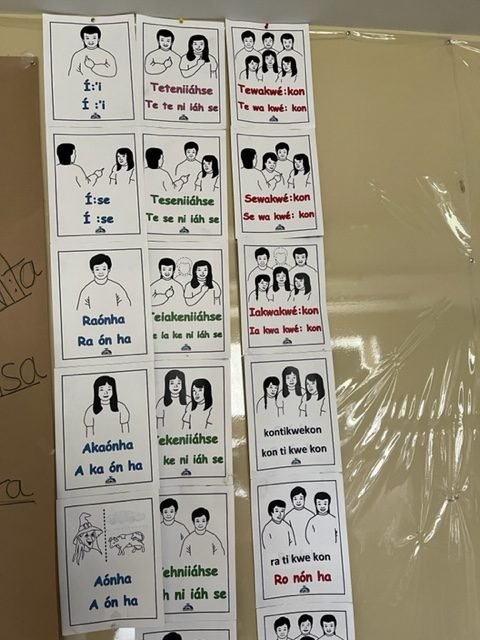Mohawk names
Leonard Atonnion Bordeau pictured sitting at his classroom desk at Kahnawake Survival School in 2006. (Courtesy: Leonard Atonnion Bordeau)
Story told by Leonard Bordeau
Growing up, we only used the Mohawk language so when I started going to Kateri School in Kahnawake, I only knew maybe half a dozen words of English. So I had a hard time. But within that first year, I’ll say I had a pretty good command of English.
All the time, my father used to tell me it’s important that we keep our language. I’m glad that I grew up with it and that I never really lost it.
Because I speak the language, I got involved with teaching. So I spent over a year at Karonhianónhnha with the little kids. Then the following year, they sent me to Kahnawake Survival School where I spent six years.
I would start by teaching them the sounds chart. In our language, we have six vowels and eight consonants. The students look at the sounds chart and we use repetition. That’s how you teach them.
I decided early on that I have to get to know my students. It took awhile because I had students from grade 7 all the way up to grade 11. I would have 60, maybe 70 students and they all use their Mohawk names. It took me a while to get to know all of them, maybe a month, but after a while, I knew them all by their Mohawk names.
A lot of them, I never found out what their English name was because we only used the Mohawk names.
Kanien’kéha kahsenna’shòn:’a
Kanien’kéha language chart at the Kanesatake Language and Cultural Centre from 2022 (Courtesy Kanerahtenhá:wi Hilda Nicholas)
Leonard Bordeau roká:raton
Shontaionkwatehiahróntie’, Kanien’kéha khók iakwatewennontáhkhwahkwe’ né: ká:ti’ shontakatáhsawen’ akaterihwaienstà:na’ Katerí: tsi ionterihwaienstáhkhwa’, sha’tewatasenhtsherí:hen Tiohrhèn:sha kewennaienteríhne’. Wakentorà:sehke’. Nek tsi, tsi niióhseres thí:ken tiotohseratierénhton, enkì:ron’ ní: tsi wa’kewennarèn:nha’ Tiohrhèn:sha.
Tió:konte shes rake’níha rakhró:ri tsi niiorihowá:nen aietewawennanónhstate’. Wakerien’tí:io’s tsi wakatehiahrónhkwen tánon’ iah tewakatewennahtón:ni.
Takatáhsawen’ akherihónnien’ ase’kén kahrónkha’ tsi nitewawennò:ten’. Né: ká:ti’ skáhere’ ne tsóhsera nikarì:wes wa’kherihónnien’ ne ken’ nihonnà:sa Karonhianónhna’ tsi ionterihwaienstáhkhwa’. Sok ki’ tsi saióhserate’, ia’onkwaténniehte’ Kahnawà:ke Survival School tánon’ 6 niiohserà:ke tho ítke’skwe’.
Entkatáhsawen’ shes enkherihónnien’ ne iewennonnià:tha’ kahiatónhsera’. Tsi nitewawennò:ten’, ionkwahiatónhkwaien ne iá:ia’k ní:kon kontiwennísa’s tánon’ sha’té:kon ní:kon kontihiatonhkwakwe’ní:io. Enhatika’én:ion’ ne iewennonnià:tha’ kahiatónhsera’ ne ronteweiénstha’ tánon’ tenthonthna'néta’. Tho ní:tsi enhsheríhonnien’.
Iosnó:re ia’tewakerihwaién:ta’se’ tsi ó:nen’k tsi enkheientéhrha’ne’ ne kherihonnién:ni. Kwah ki’ ken’ nikarì:wes tsi niió:re wa’kheientéhrha’ne’ ase’kén kherihonnién:ni 7 tsi kahiá:ton tsi niió:re 11 tsi kahiá:ton. Kherihonnienníhahkwe’ 60, tóka’ ni’ 70 nihá:ti ronteweiénstha’ tánon’ akwé:kon róntstha’ Kanien’kéha tsi nihotihsennò:ten’s. Karì:wes onkwatiénwahste’ akwé:kon wa’khehsennaientéhrha’ne’, sewenhnì:ta’ tóka’ nikarì:wes, kháre ó:nen akwé:kon Kanien’kéha tsi ní:tsi khehsennaienté:ris.
É:so iá:kon, iah nonwén:ton tewaktokénhse’ tsi nihotihsennò:ten’s ne Tiohrhèn:sha ase’kén nek ié:ken Kanien’kéha kahsenna’shòn:’a iakwátsthahkwe’.
Edited by: Emma McLaughlin, Local Journalism Initiative Reporter
Translation by Sahawisó:ko’ Arquette


